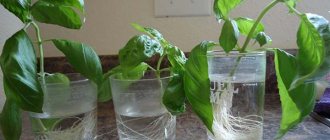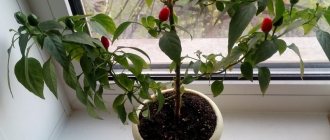Growing greenery on a windowsill in winter for beginners is a very real task. You just need to create suitable conditions for it and choose those of its types that will feel good even indoors. A mini-vegetable garden on the windowsill today is not only a practical, but also a fashionable solution within the framework of the current eco-trend and the promotion of a healthy lifestyle.
Of course, it is very convenient to always have fresh parsley on hand, but at the same time such a garden not only provides the family with fresh herbs and vitamins, but also becomes a decoration of the kitchen.
What greens can you grow at home?
Greenery on the windowsill all year round is not the most difficult task. Of course, each gardener decides for himself which crops will make up this vegetable garden on the window. But you need to take into account the peculiarities of growing one or another greenery at home. The purpose of their breeding is to obtain a high yield, and you need to choose those varieties that ripen quickly.
In most cases, greens at home are grown from seeds. But, of course, it all depends on the culture itself. So, green onions are grown from a bulb. This is generally one of the most common garden crops that grow on windowsills. On the one hand, it is very easy to grow it, on the other hand, it is a whole storehouse of vitamins. Many housewives are afraid to grow it because of the unpleasant smell, but it only occurs when the bulbs are kept in water for too long. And if it is grown in the ground, then there will be no smell.
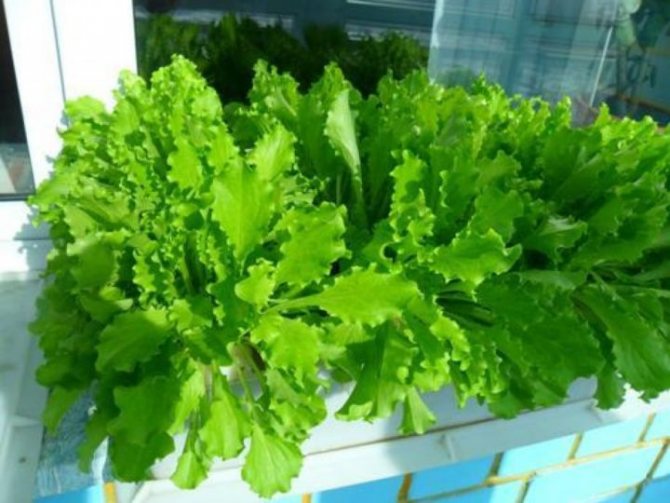
Leaf salad
A home garden on the window often includes spinach. This is one of the most common types of greenery, as it sprouts quickly and looks beautiful in a pot or neat box.
Dill can also be grown on the windowsill, but only some of its varieties, since it ripens quite late, even in the best case, its first sprouts will appear only a month after sowing.
And, of course, the window garden includes parsley. Unlike other types of greens, it is grown from root vegetables, in which the whole upper bud must be preserved. Dill is grown in fairly tall pots or boxes. But most types of salad do not require this.
In addition, it is recommended to use peat tablets or cassettes for them. Experts advise buying several types of lettuce, with leaves of different shapes and colors. Firstly, the plants will look more decorative, and secondly, the greenery on the windowsill will be all year round, since different species differ in terms of ripening. The most unpretentious type is watercress. It does not grow so luxuriantly, but because of the characteristic shape of its small leaves, the pot of greenery seems curly.
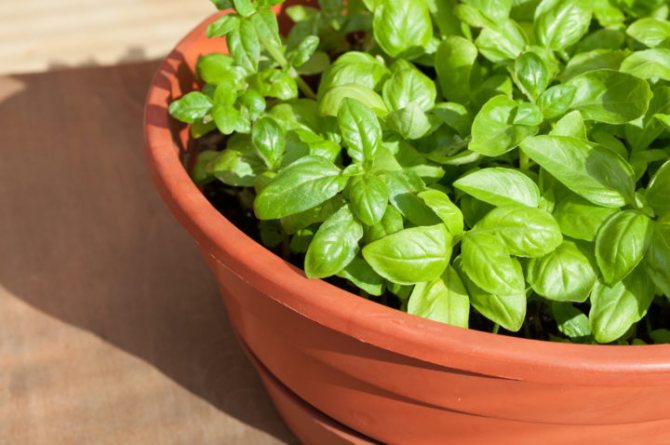

Growing basil
In theory, a window garden could include more crops. But not all of them will grow in winter lighting conditions. And some for normal development need a stable above-zero temperature outside the window. This applies to crops such as arugula, basil, watercress, marjoram and thyme. To make the seeds of these crops sprout faster, they arrange something like a mini-greenhouse, covering the pots with a film, under which there will be a comfortable temperature and humidity for these species.
Green salad on the windowsill
Juicy green lettuce leaves are an indispensable addition to many vegetable and meat dishes. This plant is popular with lovers of tasty and healthy food. That is why many gardeners are wondering how to grow a salad on the windowsill of their apartment. Experts recommend using for this purpose such types of salad as Odessa, Rand Credo, Lol Rossa.
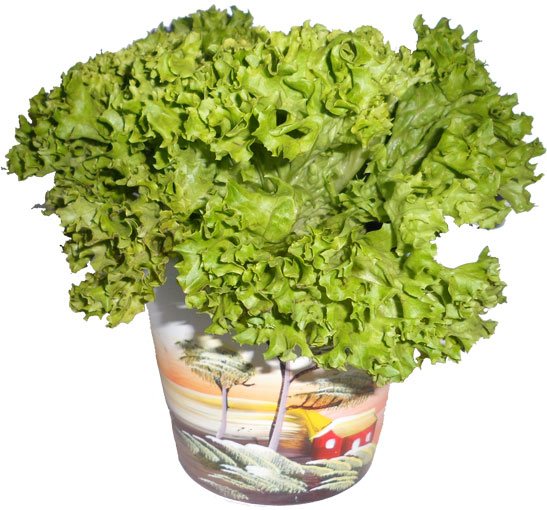

Growing lettuce on the windowsill. Photo
You can grow this plant in a pot of soil throughout the year. The lettuce produces lush greens but quickly recedes by firing arrows. Having collected a crop once, the bush must be destroyed, and a new plant must be planted in its place.
Planting and grooming secrets
Before planting, lettuce seeds should be kept in a slightly pink solution for several hours. potassium permanganate... After that, they need to be planted half a centimeter in the ground. It is better to immediately use a large enough container, since the salad does not like transplanting. But what he really loves is a lot of light and moisture moisture. In conditions of excessive dryness and poor light, the leaves of the plant become weak and pale. The salad should not only be watered, but also generously sprayed. In winter, the plant needs lighting.
Having planted the seeds in the ground, the container must be closed with cellophane and not opened until the sprouts hatch. This happens, as a rule, for 3-4 days. The optimum temperature for plant growth is 18-20 degrees Celsius. The heat has a negative effect on the harvest, as it accelerates the release of arrows by the plant.
General rules for growing greens
A garden on the window is not difficult at all, the main thing is to follow general recommendations. You can grow greens in ordinary flower pots, and in wooden boxes, which should be not only convenient, but also beautiful. In addition, the drawers should be made in such a way that they do not allow water to pass through. It is very important to choose the right pot parameters. The optimal length of the container for most types of greenery is 40-50 cm. The width should be 20-25 cm, and the height should be 12-15 cm. A drainage hole must be made at the bottom. In such a pot or container, a drainage layer must be arranged. To do this, use expanded clay, broken brick or even just coarse clean sand.
It is not enough to know how to grow greens at home, you also need to be able to find the optimal place for it. As a rule, greens prefer warmth and sunlight, so it is better to grow them in a south or southwest window.
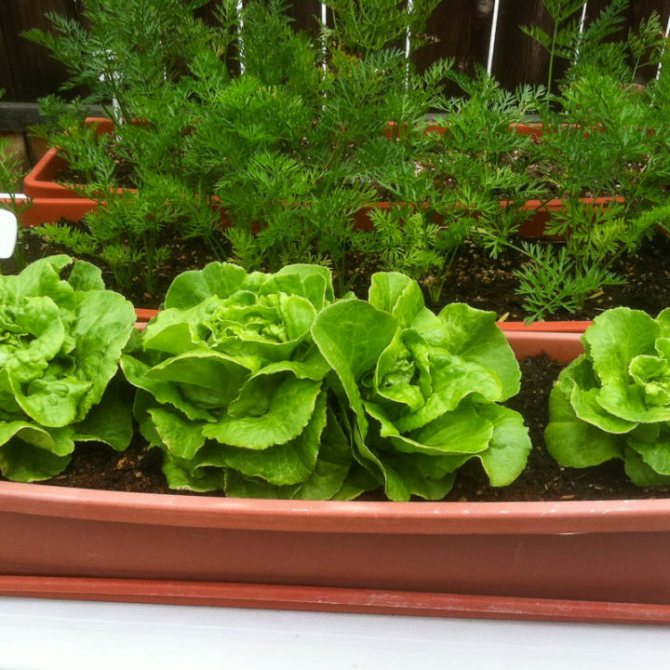

Kitchen garden on the windowsill
Before planting, it is imperative to water the soil prepared for distillation with hot water, then crush it and make grooves in it: then seeds are poured into them, and a layer of earth about a centimeter thick is added on top.
Greens are usually watered every other day, usually in two doses and in small portions. It is recommended to warm some seeds before planting and first germinate in damp gauze. But this mainly applies to crops such as asparagus.
Growing greenery at home means creating the most comfortable conditions for it. So, most of these crops are harmed by dry heat from radiators... In order not to harm the plants, the battery can be covered with a special shield and a humidifier can be used. This is also useful for creating a comfortable microclimate in scrap. If it is not possible to buy such a device separately, you can make an impromptu humidifier by simply putting a piece of wet cloth on the battery.
In winter, greenery lacks light... Therefore, many plants grow pale, and there may be less vitamins in them. In such cases, use additional illumination using ultraviolet lamps. For most crops, the optimal daylight hours are 12-16 hours.
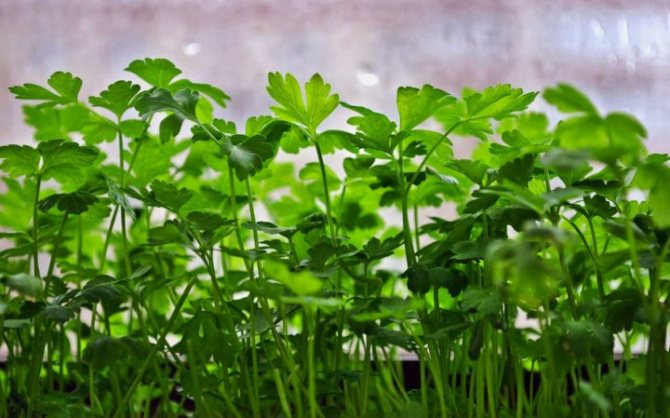

Lovage
However, pale leaves can mean chlorosis, which often occurs due to problems in the acidity of the water. The fact is that tap water is often a more alkaline medium, and therefore a number of nutrients (phosphorus, manganese, iron, boron) cease to dissolve in the soil, plants do not receive them, and this affects their condition. In this case, you need to take care of the water for irrigation; in extreme cases, you will need to add special phyto-mixtures to it.
With home-grown crops, you can safely replenish your diet. Firstly, in this case, it is known for sure that all this was grown without chemistry. Secondly, greens that were picked and used almost immediately retain more vitamins than those that have been in the store for a long time.
Method two, traditional
This method is more costly and laborious than the first method, but at the same time it is more productive.
The order of work this time will be as follows:
- Buy a flat and wide plastic tray with a height of 9-12 cm, a small package of universal soil for indoor plants and planting material - 1 kg of onion sets.
- Soak the onions in warm water for a day.
- Pour a drainage layer of expanded clay on the bottom of the planting container, fill the tray with purchased soil two-thirds of the height and plant the onions in it (without burying them in the ground and placing them almost closely one to one).
- Water your plantings with settled, slightly warmed water and place the tray in a dark pantry or in a closed kitchen cabinet, and when the bulbs hatch, move it to a light windowsill.
- Regularly, as the substrate in the container dries up, water the onion "vegetable garden" and in 20-25 days you will get the first harvest of juicy green feathers from it.
How to grow parsley?
As you know, parsley is a real storehouse of vitamins. The composition of this plant includes ascorbic acid and vitamins A and E, which are antioxidants, and B vitamins, and phosphorus, and potassium. Of course, every housewife wants such greens to be always at hand. Growing parsley is easy, but remember that its seeds take much longer to germinate than other green crops, due to the high content of essential oils. There are two options for growing it: from a root crop and by accelerating seed germination. When choosing the second option, the seeds must be thoroughly rinsed with water and wrapped in a damp cloth.
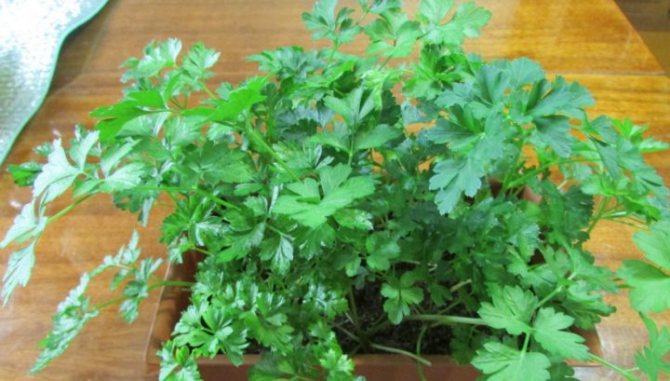

Growing parsley
The soil for growing parsley is prepared in advance. You can take ordinary garden soil, but it will need to be additionally treated with a weak solution of potassium permanganate for disinfection. You can buy ready-made soil for such crops, which is sold in garden centers.
There should be no difficulties with growing parsley. You just need to take the container a little higher than usually taken for greenery - 20 cm high. A drainage layer is placed at the bottom of the container, then covered with earth. After the soil is ready, you can plant the seeds. To do this, make beds with a distance of 10 cm from each other. Seeds are planted to a depth of no more than 1 cm. The soil is watered before planting, as described above. In the future, until shoots appear, the earth is watered every other day from a sprayer. After the emergence of seedlings, you can already water from a watering can once every two days.
At a temperature of + 20 ° C and normal illumination, parsley shoots will appear in 3 weeks.
Juicy onion on the windowsill
It is extremely easy to grow onions on a windowsill. Experienced gardeners do this in two ways:
- traditionally in the ground;
- by hydroponic method.
Owners of small windowsills, planting bulbs in the ground, can use the space wisely by arranging vertical beds. To do this, take an empty plastic water bottle and cut holes in it in a circle.Next, you need to pour the earth into the bottle in layers and lay out the bulbs in rows so that their heads stick out from the holes made. If the earth in such a structure is replaced mineral wool, then the beds will turn from traditional to hydroponic. When working with mineral wool, do not forget about rubber gloves, which will help protect your hands during landing.
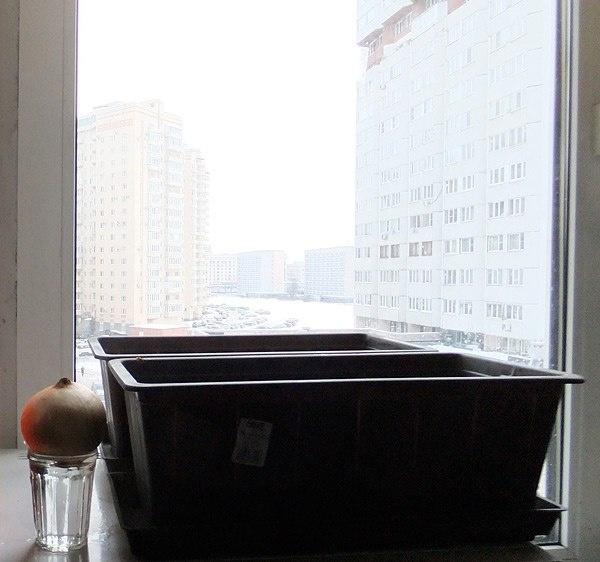

How to grow green onions on a windowsill. Photo
Growing spinach and onions
Spinach can be grown on the windowsill all year round. This culture has a taproot, which requires compliance with certain rules regarding the selection of pots for it. When caring for plants, it is important not to flood the soil and avoid contact of delicate leaves with water when watering.
Spinach is germinated in boxes or containers at least 10 cm high. Good drainage is very important for it. For this, expanded clay is usually used. Spinach seeds are planted not tightly, but at a distance of 5-10 cm between the rows. Planting depth - 1-2 cm.Under favorable conditions, greens suitable for consumption will appear in 1-1.5 months. The most delicious is the greens obtained from plants with 6-10 true leaves.
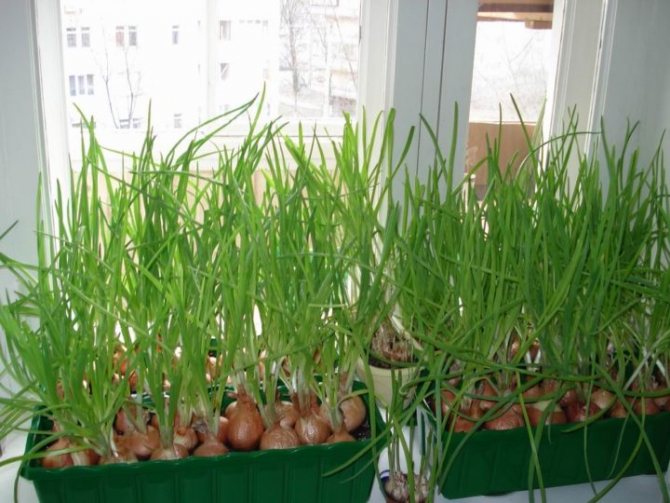

Growing onions
You can choose any onion for planting. The larger the bulbs, the more nutrients they will contain and the more greenery will be grown. But you can also plant small shallots. The ideal option is to choose several varieties at once with different dormancy periods so that the greens on the table are all year round.
In theory, onions can also be grown from seeds. But in this case, it should be clarified whether this or that variety can be grown at home.
General recommendations
- Find varieties that require similar growing conditions.
- Think well lighting for a mini-garden.
- Any soil must be disinfected before use: pour with a solution of potassium permanganate, ignite in the oven or freeze it.
- Sow seeds in well-prepared soil with top dressing.
- The soil should always be moist. Watering is carried out with warm water at room temperature, purified from chlorine. Excessive watering is just as harmful as drying out the soil.
- The air must be humid. To do this, it is worth installing a container of water near the radiator.
- The planting material must be of high quality. If they are seeds, they must be adapted for the home (look for information on the package). They should also be early ripening varieties.
- Temperature extremes should be avoided.
- To eat the harvest of your mini-garden, you should follow all the precautions with the use of dressings, fertilizers and other drugs.
Interesting design options for a mini-kitchen garden
You can place a mini-garden directly on the windowsill, if its size and degree of illumination are suitable for plants.


If there is more space in the kitchen, and you have a wall that is not occupied by cabinets, you can place the plant rack directly on the wall - from floor to ceiling.
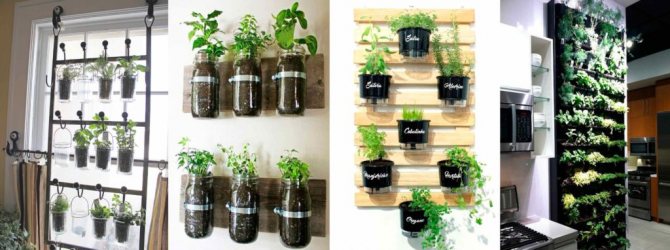

There are also more technologically advanced modern options for organizing a indoor garden - special devices or full-fledged mini-gardens with lighting and irrigation systems.


Tags: greens, greens on the windowsill, kitchen garden, vegetables
About
- Similar posts
- Practical modern kitchen design for the avid chef
- What should a novice pastry chef buy first? Essential confectionery in your kitchen
- Decorating Easter eggs. How to decorate Easter eggs and make a pysanka for Easter
«Previous post

